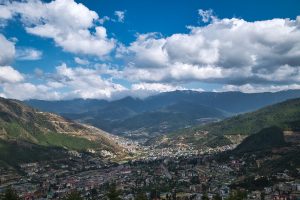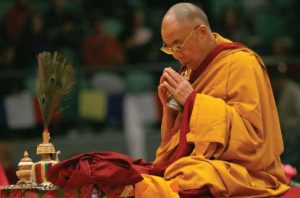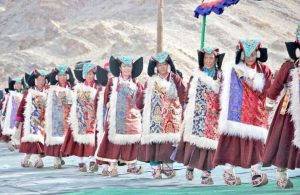Aung San Suu Kyi has made big sacrifices for the people of Burma. In the recently released film, “The Lady”, Michelle Yeoh the actress makes great efforts with passion to portray Suu Kyi, to the extent that Yeoh even becomes terribly thin in order to play the hunger strike scene appropriately. In the film, Suu Kyi’s deep sorrow from the separation from her husband is delicately depicted, and the scenes of the brutal treatments to the arrested students are astonishing. All these scenes will surely make you shed your tears, and especially to me, when I think of the Burmese people who have treated me so well.
I personally have visited the meditation centers in Yangon: Chanmyay in Pyin Oo Lwin, Panditarama, and Shwe Oo Min where the masters have given me guidance on Vipassana, and Loving Kindness (Metta) meditation. The enthusiastic volunteers there run around every day just to help us get our visas, buy things, cook and wash the dishes. These volunteers truly understand how the mind works. They work very hard to overcome their own personal greed, and they do their best to help those beginners like us in our mindfulness practices despite numerous demands, dissatisfaction and even rudeness at times from the visiting newcomers.
When asked how they could remain so patient, a volunteer replied kindly, “you left your countries to come all the way here to learn, and mindfulness practices are not easy at all. Therefore, we should take good care of you”. I was truly touched. Every time I leave Burma, I feel great gratitude and tears just come down. The film “The Lady” is showing now, and I enjoy watching it. Just by seeing the Myanmar landscapes again, its sky and the Shwedagon Pagoda will ease some of the melancholy in my thoughts of my Burmese friends.
Once, a Burmese volunteer drove me and several other friends from around the world to a place, passing by Suu Kyi’s residence. It was surrounded by a dense foliage on which laid some red banners and flags of the Democratic Alliance. The volunteer explained, Panditarama Sayadaw has taught Suu Kyi in meditation, and thus the government did not like the Zen master, and has made things difficult for him”. I am sure that Suu Kyi must have had very good meditation practices under such good guidance. A few months ago, when Daw Than Myint came and visited us, she mentioned that once when Suu Kyi was under house arrest, Chanmyay Sayadaw went to her home to visit and gave her guidance on her meditation practices. And after that the government had forbidden Sayadaw to visit her further.
Unfortunately, the movie does not contain any scenes of Suu Kyi’s sitting or walking meditations.
A journalist once asked Suu Kyi, When you speak to the people you talk a lot about religion, why is that? Suu Kyi replied, Because politics is about people, and you can’t separate people from their spiritual values”. On the occasion of the award of the Nobel Peace Prize in 1991, Suu Kyi’s son Alexander Ari gave an acceptance speech on behalf of his mother and he said: “Although my mother is often described as a political dissident who strives by peaceful means for democratic change, we should remember that her quest is basically spiritual”.
The book “Freedom from Fear and Other Writings” is a collection of Suu Kyi’s speeches, letters, and interviews, and in the ‘My Country and My People’ article, Suu Kyi recounts the Burmese style, the history and the festivals derived from Buddhism. She delineates the rise and fall of the ancient dynasties of Myanmar, briefly talks about the evolutions of different Buddhist schools, the history and the teachings of the Buddha including the Noble Eightfold Path, the Precepts, and the pursuit of liberation. These all show fully her familiarity with, and her passion for the Buddhist teachings. In one article in “Freedom from Fear, she gives a detailed analysis on our mind:
“It is no power that corrupts but fear itself. Fear of losing power, corrupts those who wield it, and fear of the scourge of power corrupts those who are subject to it. Most Burmese are familiar with the four kinds of corruption from the Agati Sutta. Chanda-agati, corruption induced by desire, is deviation from the right path in pursuit of bribes or for the sake of those one loves. Dosa-agati is taking the wrong path to spite those against whom one bears ill will, and moga-agati is aberration due to ignorance. But perhaps the worst of the four is bhaya-agati, for not only does bhaya (fear) stifle and slowly destroy all sense of right and wrong, it so often lies at the root of the other three kinds of corruption”.
That Suu Kyi was able to make these remarks showed that she certainly has close observation of the operation of the mind. She has experienced and demonstrated selflessness, particularly when she was released from house arrest and showed no hatred or personal grudge against those who had imprisoned her. She humbly remarked after she left her lakeside home-cum-prison that she believed that there are no evil people, but only people who do evil things. And when she saw her own image in taxis, people’s homes and in public places, she was shocked and showed no pleasure in such worship towards her. It reflects that Suu Kyi has very little ego involved. Her modesty and humbleness are the result of many years of meditation practices. After she was released, she attended the official commemoration of her father, and even used her international influence to prevent the Myanmar government from foreign economic sanctions.
Suu Kyi’s virtuous “fruit” is something that can be easily expected. As she has learned from meditation practice, she can see through the fears in the mind. She is never alone because she is supported by the strength of the entire Buddhist tradition and her spiritual Sangha. People of different religions, race, skin color – all sympathize with her and bless her. Spiritually, she is inspired by two great people: one is her father, General Aung San who led the people of Myanmar to freedom from the rule of Britain and Japan, and the other is Gandhi. In the film, there are many appearances of the portraits of General Aung San, and Suu Kyi and the female students all adore the books by Gandhi. The spiritual connotation between the two is the same: both General Aung San and Ghandi had the freedom to combat their fears.
In fact, when General Aung San died, Suu Kyi was only two years old. Her knowledge of her father came mostly from her mother who was a diplomat, and from the articles about her father that her mother collected. She found that she and her father shared the same beliefs which establish a strong spiritual connection with the heritage. General Aung San asked the people of Myanmar to not just rely on other people, but that they should have the courage to be great people themselves. Gandhi encouraged the Indians to bravely face battering without resistance, and to steadfastly maintain their inner peace in order to achieve peace in the outside world. This practice takes lots of discipline. Suu Kyi is a very disciplined person herself and last year she gave a speech to Hong Kong University students via a video link, and she encouraged them to have discipline. While under house arrest, Suu Kyi continued to practice and tried to maintain mindful thoughts, even when she often had to repair the electrical appliances by herself. Unfortunately, the film has not reached this depth, and the actress who portrayed her might in fact have over-expressed some grief, stubbornness and anger. Of course in real life, Suu Kyi does feel pain, and she surely would cry, and yet she is more likely to use mindfulness practices to watch the mind and overcome suppression and prolonged pain. Suu Kyi has learned that no emotions are permanent when she stated:
“Fearlessness may be a gift but perhaps more precious is the courage acquired through endeavour, courage that comes from cultivating the habit of refusing to let fear dictate one’s actions; courage that could be described as ‘grace under pressure’ – grace which is renewed repeatedly in the face of harsh, unremitting pressure.”
If you can sit quietly for 45 minutes to try and keep still and concentrated, you can surely experience the fears that stiffen the body, and the fears that trouble the mind. You can also experience your inertia to escape from, resist and hate fears. However, skilled meditation practitioners just sit steadfastly and are calmly aware of all this. Gradually, you will find a new way to face fears: using curiosity, gratitude, faith and compassion to calmly face fears. On the outside nothing seems to be happening, and yet inside, you will have an inner journey to explore the mind, reflect and learn. This is how we learn and develop self confidence.
Sometimes Vipassana meditation practice can seem very dull, and another method is to switch to loving kindness meditation. According to Chanmyay Sayadaw, this is like when a traveler has walked in the hot sun for a long time, he will need a little rest in the shade. In the loving kindness meditation, one needs to repeat short sentences of blessings in order to train the mind to concentrate on virtuous thoughts and cultivate the virtue of loving kindness. I am sure that Suu Kyi must have practiced loving kindness meditation. In August 26, 1988, she gave her famous speech at the Shwedagon Pagoda in Yangon, and she concluded the speech:
“May the entire people be united and disciplined. May our people always do what is in complete accord with rightful principles. May the people be free from all harm.”
Also in her speech to the Hong Kong University students in 2011, Suu Kyi said:
“The highest form of learning would be that which makes us caring and responsible citizens of this world, and equips us with the intellectual means necessary to translate our concerns into specific needs.”
She has inherited these values from the Buddhist teachings, from her father and from Mahatma Gandhi. And I can see these values within the beautiful people of Myanmar.
May peace be with Suu Kyi.
May the Burmese people be safe.
May all beings be well.
* * * * * * * * *
Additional Reference:












